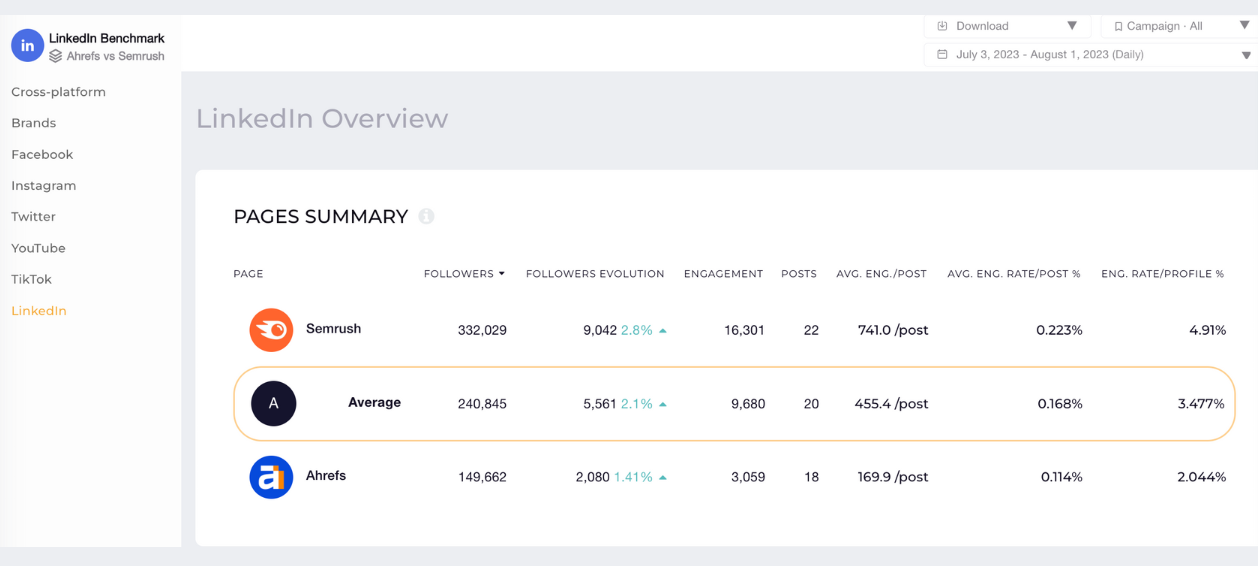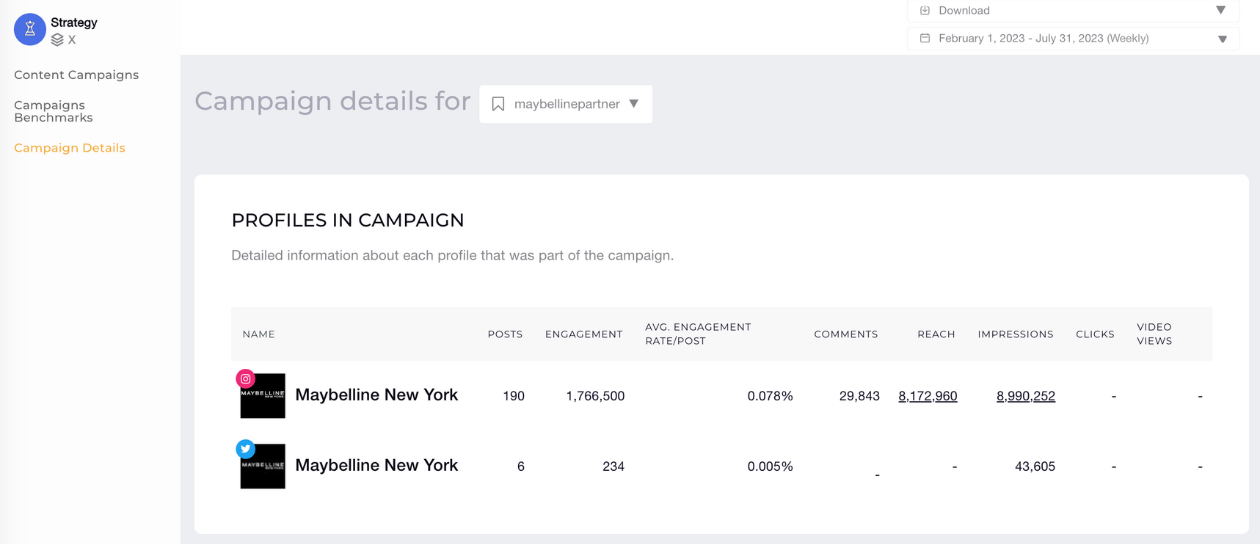As a brand marketer, you can't have “social media” without a strategy.
When establishing your brand’s social media presence, relying on luck is not an option if you really want to be successful.
Trends come and go and you have to act quickly to stay on top of people's minds, always paying attention to the audience and your competitors.
To help you out, I prepared some tips and tricks on developing a top-performing social media strategy.
How to create a top-notch social media strategy
- What is a social media strategy?
- Why do brands need a strategy for social media?
- How to create a social media content strategy in just 6 steps
3.1. Set your social media goals
3.2. Do your research
3.3. Select your target platforms
3.4. Create engaging content
3.5. Schedule your content ahead
3.6. Measure your performance - How to develop your social media strategy with Socialinsider
- How to know if your social media strategy is working
- Social media strategy template
1. What is a social media strategy?
A social media strategy is a plan through which you make a list of your goals and all the actions you have to take to reach them.
This plan has to follow a number of clear steps and should be supplemented by a tool for measuring social media performance.
Ideally, you should also set a few milestones along the way, to keep track of your progress and see where you should improve.
2. Why do brands need a strategy for social media?
This question is as unnatural as asking yourself why you need to breathe. It is clear that you need a strategy in order to survive on social media.
Without a social media strategy, you're essentially flying blind. You have no sense of direction or idea of how much you're progressing.
Posting randomly will prevent you from creating a cohesive social media brand identity that people can love and easily recognize.
To thrive on social media, you need a powerful strategy, with a handful of people behind that really know how to work together to accomplish the brand’s goals.
Through your well-planned social media content, you will manage to increase brand awareness and deliver personalized content.
That in turn will result in improved customer service and a better way to direct users towards your site and increase traffic.
Just like in a game of domino, this will impact your ability to convert leads and convince people your product is the right answer to their needs.
Social media networks frequently roll out shoppable features that help marketers ease the purchasing experience.
As a result, your social media content strategy should use shoppable content to influence potential customers' purchasing decisions and eventually boost sales.
After learning the benefits of having a social media content strategy for your brand, let's look at how to develop one that will set you apart from the competition.
3. How to create a social media strategy in just 6 steps?
The days of creating social media profiles and posting random stuff in the hopes of seeing results are long gone.
Today, social media is an integrated aspect of a company's overall marketing plan.
Regardless of how big or small your business is, having an effective content strategy in place is crucial to reaching your target audience.
And while taking the time and resources needed to develop such a complex plan can be overwhelming, we're here to give a helping hand.
Let’s see what it takes to create a successful social media content strategy.

3.1 Set your social media goals
Determining your goals influences how you prioritize your content and prevent you from wasting your budget on methods that won't bring results.
According to our study on The Life of A Social Media Manager, the primary social media goals of social media managers are increasing brand awareness, growing the brand’s audience, and connecting with the audience.

Make sure you align your social media goals with your larger business objectives to achieve the best results for your brand.

3.2 Do your research
To build a successful social media marketing strategy, there are two main things that you’ll need to research first:
Who is your target audience?
Who are your competitors and what are they doing?

When it comes to target audience, the key to success on social media is understanding what their needs are and what are their desires.
Creating buyer personas is a fantastic way to pinpoint your target audience for social media.
You should use social media analytics tools to get information about your audience’s age, location, income, occupation or industry, interests, and behaviours.
If you don’t know where to start, you may want to use our template to sketch out your ideal buyer persona.
When it comes to competitors, conducting a competitive analysis allows you to understand your competitors' identity, strengths, and weaknesses.

Mapping out their features can help you spot opportunities.
To create a more comprehensive competitive analysis for social media, you may want to try using our following social media strategy template.
This way, you’ll see exactly where to direct your social media efforts.

👉 If you’d like to know how to calculate the engagement rate for different social media platforms, you can check out our article where we explain the math behind engagement rate.
Keep in mind that you may also use social media listening tools to track online brand mentions, identify trends before your competitors, and handle communication crises.

3.3 Select your target platforms
Being on more social media platforms has its obvious advantages.
More visibility increases reach, which increases sales.
The more online platforms your products are available on, the more potential customers you reach, and the more likely they are to make a purchase.
However, you don’t necessarily need to be active on all social media platforms simply to check that out.
You only need to be on the platforms that are relevant for your target audience.
This is why it is so important to evaluate your target audience, understand the buyer persona and establish your brand identity.
3.4 Create engaging content
It’s time we get to the fun part—creating top-notch content.
While content creation may seem like a breeze to non-marketers, it can actually get quite overwhelming.
When creating posts, social media managers should aim for quality over quantity.
Brands need to understand that the overall goal of content creation should be to inform, educate, and entertain—without being overly promotional.
If you’ve decided which platforms to leverage as part of your strategy but lack content ideas, you might want to take a look at the few resources we gathered and get inspired.
Working with existing assets and templates and editing them into specific platform-friendly formats is the way to do it.
Content ideas for different social media platforms:
- 12 Instagram Post Ideas You Should Try in 2022
- Instagram Reels Ideas for Brands Across 10 Different Industries (+Examples)
- Instagram Story Ideas to Engage With Your Audience
- 11 TikTok Content Ideas for All Businesses
- 7 LinkedIn B2B Content Ideas for Social Media Managers and Small Business Owners
- 15 Facebook Post Ideas to Increase Engagement
- 12 Twitter Content Ideas to Engage Followers
- 50 YouTube Video Ideas for Creators To Get Inspired
3.5 Schedule your content ahead
Before starting any campaigns, you have to decide on how frequently and at what times you will post content to key social media platforms.
SEO Guru Semrush recommends:
The easiest way to monitor your postings and see how your feed will look is to create a social media content calendar and plan ahead.
To make content planning easier, you can use our example of a weekly content calendar.

Marketers may also use scheduling tools to automate publishing to social media platforms from a single dashboard, saving significant time.
A good social media strategy, however, includes much more than just planning and publishing your content.
Social media management—which includes finding ways to engage the audience and responding to inquiries—should also be a part of your social media content strategy.

3.6 Measure your performance
After taking all these steps, it's time for the last and probably most important one: checking your progress.
4. How to develop your social media strategy with Socialinsider
Now that you've laid the foundation for a powerful social media strategy, it's time to make it even better with data. And for that, you can rely on a professional social media analytics tool like Socialinsider.
One of the pillars of a strong strategy for social media is setting realistic goals and making smart decisions when it comes to creating, sharing and tweaking your content.
The first step in developing your strategy is doing research - on your industry / niche, as well as your competitors.
That's how you find out what is working and what's not, and start making a plan for your content based on real-time data rather than mere assumptions.
In Socialinsider, you can perform an in-depth competitive analysis to find our what your competitors are doing, where they are most active (which platforms) and how well their content is performing.
This will help you set realistic goals for your brand and identify any gaps in the industry that your product can potentially fill.
To start a competitors analysis, you need to first add your competitors' profiles into the app. Once that's done, you can navigate to the Benchmarks section to get an overview of their performance versus yours:

You can do this for an individual platform or across all channels (cross-platform).
Say you're Ahrefs in the example shown above. Using the Benchmarks feature you can see how you stack up against your top competitor (Semrush) or the industry average.
Alternatively, you can group their profiles in a Brand and access brand-level competitive data:

While developing your brand's social media strategy, it might be useful to draw inspiration from your competitors' most recent or popular social media campaigns.
Luckily, you have a way of finding out what those are using the Strategy tool in Socialinsider.
Once you've connected your competitors' accounts in the app and navigated to the Strategy section, you will get some campaign suggestions based on that brand's most used hashtags.

For example, Maybelline uses the hashtag #maybellinepartner for its influencer marketing campaign, and we can check the overall performance of that campaign using the Strategy tool:

Or check their top 10 best performing posts in that campaign:

Besides competitors and industry research, you can use a social media analytics tool like Socialinsider to check how well your content performs in real-time and make adjustments on the go.
5. How to know if your social media content strategy is working?
Now that you've created and shared your content, you will need to conduct a social media audit.

Keeping track of your metrics allows you to determine which type of content resonates best with your audience and whether your content is helping you in achieving your social media objectives.
Based on the platform you chose to leverage, you might want to look into what metrics to use and how they can indicate your content strategy's success:
- Most Important 14 Instagram Metrics Marketers Should Be Tracking in 2022
- TikTok Metrics You Should Be Tracking in 2022
- Top 10 LinkedIn Metrics to Track in 2022
- Top 10 Twitter Metrics and How to Measure Them
- Top 11 Most Important Facebook Metrics to Track and Monitor in 2022
- What Are the Most Important YouTube Metrics You Should Include in a Performance Report
6. Social media strategy templates
Having all the necessary information about social media strategy at your disposal may not be enough. That is why we also included a social media strategy template to guide you through the process.
Click here to access your social media strategy templates.
Final thoughts
Crafting a social media strategy with Socialinsider is not only really easy and intuitive, but will also reveal new useful insights meant to empower your brand.
By having a social media plan, you can build brand awareness and increase your website’s traffic. At the end of the day, leveraging analytics data to create a strategy for social media will definitely pay off.
Frequently Asked Questions
1. What is the 50-30-20 rule for social media?
The 50-30-20 rule for social media dictates that 50% of your posts should be made to engage, 30% to inform, and 20% to promote.
2. What should be included in a social media strategy?
Most social media strategies should include these 8 elements:
- Realistic goals
- Audience insights
- Competitive research
- Social media audit
- Accounts setup
- Content calendar
- Content creation
- Performance tracking
3. What are the objectives of a social media strategy?
The objectives of a social media strategy may different from one brand to another. Most commonly, a strong social media strategy is meant to boost brand awareness, build communities and generate sales.








